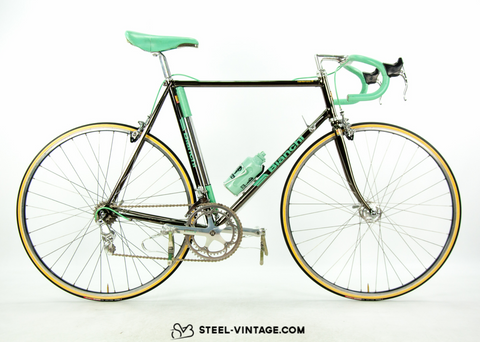The foundations of the brand
Edoardo Bianchi is arguably one of the most important figures in the world of bicycles. He was born in the heart of Milan in 1865, only a handful of years after the unification of Italy and thus in an extremely important time both in regard to Italian society and its economy. He grew up in an orphanage in the city centre, there he gained a wonderful education and was exposed to, unbelievably, mechanical engineering.
As a teenager he was sent to be a mechanic’s apprentice, once he started earning his own money he began to donate to the institution that had raised him and given him such a valuable start in life.
Just before his 20th birthday in 1885, Edoardo opened his own mechanical business, he was ready to go it alone. His motto was simple and clear: using the best components, offer the best possible product - something that the brand still prides itself on today. The company produced many items with incredible detail, medical tools and vehicles were two of the most successful categories of items for Bianchi, to begin with. Nevertheless, one machine grabbed Edoardo’s imagination and became an infatuation for him: the velocipede (a man-powered vehicle consisting of one or more wheels) the most common variety of this was the bicycle. At the time, bicycles were constructed with one wheel larger than the other - this didn’t seem logical to Edoardo who began experimenting with equally sized wheels.

An example of Bianchi’s vision realised on Fausto Coppi's 1946 Track Bike.
Do you think this design worked?
Following John Boyd Dunlop’s invention of the pneumatic tyre in 1887, Bianchi trialled using the same technology in 1888 which revolutionized the brand and propelled them towards national success.
The success continued into the 1890s as bicycle travel became a more popular form of transportation for the general public, at the turn of the decade Edoardo was called upon by the royal court to teach Queen Margarita how to ride a bicycle. He did not hold back for the occasion and made a completely custom bicycle complete with a diamond-encrusted chainguard! Queen Margarita was so impressed that her success in the saddle spread far and wide with dignitaries from other Italian states and Portugal wanting Bianchi’s expertise. In 1895 Bianchi was appointed official supplier by appointment to the Royal Court. This royal interest coincided with an explosion of people wanting to ride bikes amongst the general public.
Naturally, the next progression for the sport was a competitive one. Many national races were popping up in Italy, as those that had been bitten by the cycling bug were not testing themselves against others. Needless to say, Edoardo and his business were very much involved. The competitive element was good for Bianchi as it meant there were constant ways to test different inventions and always pressure to ensure that your bike would be the best. In 1899 the first notable victory on a Bianchi bike was achieved by Giovanni Tomaselli at the Grand Prix de la Ville de Paris. This success propelled Bianchi to being a leading commercial brand and once Tomaselli’s career ended, he became a key financial advisor to Bianchi.
The early formative years of the brand set them up for greatness, but it was only through hard work and dedication that the brand cemented itself as a legendary bike brand. They prided themselves on their workmanship and championed Italian components so that every bicycle they produced was an all-Italian thing of perfection. Their care and understanding of the process involved in creating a winning racing machine were noted by sports fans and successful cyclists. Within the professional racing scene, riders of Bianchi bikes were always considered as challenging for victories.
Vintage Bianchi bikes can still be in excellent working order, the skill involved in the construction of the bikes has meant that they have stood the test of time. They are often timeless classics that will turn the head of any fan of cycling, and understandably so. The early experiences that Edoardo Bianchi encountered, meant that the brand was set up for success as long as the ethos that was so important to him was continued: attention to detail, skill and high-quality parts. Therefore you can be assured that vintage Bianchi bikes are of the absolute highest quality.
You may have seen the distinctive shade of blue and green that is synonymous with Bianchi bikes. The correct name for this colour is Celeste. This word translates from Italian to English as Heavenly, Celestial or Blue and from looking at the colour, one can understand why!

Here is an example of a 1940s Bianchi Folgore in the classic Celeste colour.
Many brands on the market try to have instantly recognisable logos, but nothing quite grabs the attention like the striking celeste colour. Any cyclist will spot it a mile off and be able to tell you the brand of the bicycle - that’s better than any logo. This beautiful shade of blue and green has a very interesting backstory too - there are many theories circulating regarding the origin of where it originated from and why it has remained so central to the brand.
The Milanese sky - the most pragmatic reason that people have come up with for the origin of the colour is by simply believing that it represents the beautiful colour of the skies above the Bianchi factory. People believe that Edoardo wanted to pay homage to the place that inspired him so much and helped him on his way to success.
Excess military paint - another interesting theory is that following the war years the bicycle industry was struggling financially so corners were cut where they could be. One of which was the unused paint by the Italian military was sold off very cheaply as a way to accrue lost funds, which companies needing paint snapped up quickly. Bianchi, combining all these paints, uncovered a striking blue/green colour that was economical and recognisable, and so it stayed!
Queen Margarita’s eyes - arguably the most fanciful yet romantic story is that whilst Edoardo Bianchi was teaching Queen Margarita how to ride her custom-made bicycle, he became so enthralled with her eyes that he painted all his bikes the same colour.
The 10 most iconic Bianchi bikes ever
Bianchi Tipo M
This was the top model in the 1920s; the Tipo M is a lightweight racing bike equipped with the famous "Giro Ruota" gearing, a flip flop hub with freewheel and a single cog-to-be switched manually according to the rider's needs.

Bianchi Saetta from 1937
Produced between 1933 and 1939, the Bianchi Saetta (Italian for thunderbolt) was a lightweight, lugged steel frame with particularly refined lugs, iconic Bianchi head-tube with an integrated headset and a chain oiler at the seat tube.

Bianchi Folgore from 1940's
Produced between 1940 and 1949, the Bianchi Folgore is inseparably connected with the epic victories of Fausto Coppi at the 1946 Milano-Sanremo and the 1947 Giro d'Italia. Normally equipped with the iconic Campagnolo Cambio Corsa: a two-lever operated gearing system located on the seat stays developed by Tullio Campagnolo.

Bianchi Paris-Roubaix from 1950's
Produced between 1950 and 1952, the Bianchi Paris-Roubaix is one of the Milanese brand's most iconic models. It takes its name from both the Hell of the North (the informal name for the and Campagnolo's unique Paris-Roubaix groupset).

Bianchi Tour de France
Designed in 1952 and manufactured in 1953 to celebrate Coppi's enormous victory in the 1952 Tour de France; Bianchi produced a prestigious model called the Bianchi Tour de France. However, it did not remain in the catalogue for long and by the end of 1953, it was never made again. Bianchi Tour de France is hard to find.

Bianchi Campione del Mondo 1950's
If you have ever seen pictures of professional racers like Fausto Coppi riding a Bianchi bicycle, you have most likely seen a Bianchi Campione del Mondo. First released in 1954 to celebrate Coppi's 1953 World Championship. The combination of headtube lugs and steering set is so amazingly beautiful that one can easily spend hours admiring them.

Bianchi Specialissima from 1960's
Released in 1958, the Bianchi Specialissima was made to be as light as possible whilst retaining the stiffness required to translate the power of professional cyclists into formidable speed. With a 27.2mm seat tube, head-tube oiler and a Campagnolo Record Strada Groupset, the Bianchi Specialissima was built by the Bianchi Reparto Corse – the Bianchi Racing Division – with competition in mind. The same model was subsequently used by the legendary Bianchi-Salvarani Team in the 1960s.

Bianchi Specialissima X3
The Specialissima X3 is an extremely rare model released in the early 1980s and was only able to be bought for a short period of time. The frameset was built with Columbus tubes and differed from other models for a few, refined details: a sloped fork crown, aero-shaped seat stays, "V" shaped brake bridge. The Specialissima X3 frameset was then subsequently used to build the Bianchi Centenario model, whose very typical fork crown, rear triangle and brake bridge were basically adopted from the X3.

Bianchi Specialissima X4 Argentin Edition
Probably one of the finest and most beautiful steel racing bicycles ever produced. Bianchi produced the Specialissima X4 for six years between 1986 and 1991 – they are impeccably crafted using only the best components and are very rare indeed. A special X4 Argentin model was named after Moreno Argentin, after the professional rider of the Sammontana Bianchi team won Liège-Bastogne-Liège and the world championships of 1986 on it. Argentin had a black painted head tube and a rear chainstays and is harder to find than the normal X4 models.

Bianchi Centenario from 1985
The legendary Bianchi Centenario was developed to celebrate 100 years of Bianchi and came out in 1985. Essentially, the Centenario was developed from the epic Bianchi Specialissima X3 and included a special gunmetal cromovelato paintwork as well as a limited edition Campagnolo C Record groupset, a leather handlebar cover and seat in the typical Bianchi celeste. Bianchi Centenario with all original paint and pantographed parts is a very rare fund and extremely collectible. All frames were numbered.






